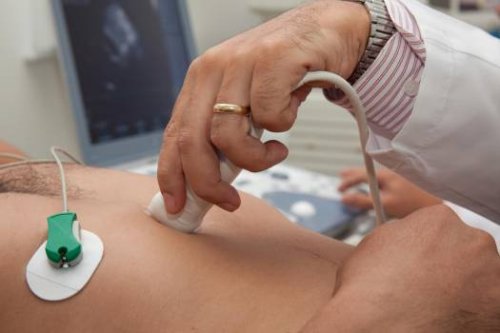Bicuspid Aortic Valve: Diagnosis and Treatment

The aortic valve usually has three leaflets (flaps). However, some people are born with a bicuspid aortic valve. This causes certain problems, since the valve should transport oxygenated blood from the heart to the aorta.
As some studies have indicated, this condition is known as a congenital cardiac malformation, and, in spite of what you might think, it’s pretty common.
While it doesn’t cause any problems during childhood, most issues start to appear during adulthood. Because of this, an early and proper diagnosis will allow you to receive the most effective treatment.
Bicuspid aortic valve
Symptoms

The diagnosis of a bicuspid aortic valve can be carried out through different methods. However, is there a symptom that you could experience that would alert you to its presence?
The truth is yes, even as a kid. Because of this, it’s important to pay attention to your child’s complaints about pain or other symptoms that we’ll list below:
- Excessive tiredness: with even a minimal physical effort they feel exhausted which prevents them from continuing.
- Chest pain: they feel light chest pain which could be accompanied by difficulty breathing.
- Heart palpitations: their heartbeats are unusually fast or irregular.
- Fainting: your child might lose consciousness due to the mentioned tiredness or for no apparent reason. They are also usually pale.
If you notice any of these symptoms, you should bring your child to a pediatrician as soon as possible, so they can do the correct tests.
Discover: First Aid: How to Respond During a Cardiac Emergency
Diagnosis

The diagnosis for a bicuspid aortic valve is carried out by reviewing your family history. If you have a history of this illness in the family, then it’s very possible that you could have inherited the problem. After that, they do a physical examination.
During the checkup they might use a stethoscope to be able to hear the irregular heart palpitations and, also, for signs of a heart murmur. After that, to verify that you have a bicuspid aortic valve, they’ll do an echocardiogram which helps to evaluate how the heart is working.
Treatment for a bicuspid aortic valve
There are different treatments that the doctor can choose from. However, it’s important to mention that they have to do regular check-ups to detect any other problems, like a widening of the aorta.
- Replacing the valve: the damaged valve is removed and replaced with a mechanical one or one made of biological tissue.
- Balloon valvuloplasty: this is done to expand the opening of the valve which tends to shrink. Due to that, this treatment normally has to be repeated.
- Surgery: the enlarged section of the aorta is removed and replaced. They can also try to repair the aortic valve.
There are many studies that continue to look for an effective solution for this congenital malformation that can affect your quality of life.
You might be interested in: Auscultation of Veins and Arteries
Regular checkups for your whole life

In spite of this treatment, a person diagnosed with a bicuspid aortic valve will need regular checkups throughout their life. It doesn’t matter if they’ve had surgery or had the valve replaced. You should visit the cardiologist every year to make sure that everything is fine and that there aren’t any new problems.
Additionally, it’s important for all the close relatives of the person with a bicuspid aortic valve to get an echocardiogram to make sure everything is okay. The reason is that this congenital defect can be hereditary. Due to this, relatives should make sure their valves are working properly.
We hope this article has helped you to learn a little more about this problem that you can’t see with the naked eye, but that shows itself through different symptoms. It’s very important to go to the doctor if someone in your family has suffered from this valve defect as this can keep your health and life from being affected.
All cited sources were thoroughly reviewed by our team to ensure their quality, reliability, currency, and validity. The bibliography of this article was considered reliable and of academic or scientific accuracy.
- Martín Cazorla, F., López Calvo, A.M., & Rubio Lamia, L.. (2014). Estenosis aórtica por válvula bicúspide: una causa de muerte súbita en jóvenes deportistas. Cuadernos de Medicina Forense, 20(2-3), 123-125. https://dx.doi.org/10.4321/S1135-76062014000200009
- Zalaquett S, Ricardo, Camplá C, Cristóbal, Scheu G, Maximiliano, Córdova A, Samuel, Becker R, Pedro, Morán V, Sergio, Irarrázaval Ll, Manuel J, Baeza P, Cristian, Arretz V, Claudio, Braun J, Sandra, Chamorro S, Gastón, Godoy J, Iván, & Yáñez D, Fernando. (2005). Ciruguía reparadora de la válvula aórtica bicúspide insuficiente. Revista médica de Chile, 133(3), 279-286. https://dx.doi.org/10.4067/S0034-98872005000300002
- Zalaquett, Ricardo, Besa, Santiago, Contreras, Juan, Gundelach, Joaquín, Muñoz, Cecilia, & González SM, Patricio. (2016). Veinte años de reparación de Ia válvula aórtica bicúspide insuficiente: a twenty year experience. Revista chilena de cardiología, 35(1), 32-40. https://dx.doi.org/10.4067/S0718-85602016000100004
This text is provided for informational purposes only and does not replace consultation with a professional. If in doubt, consult your specialist.








